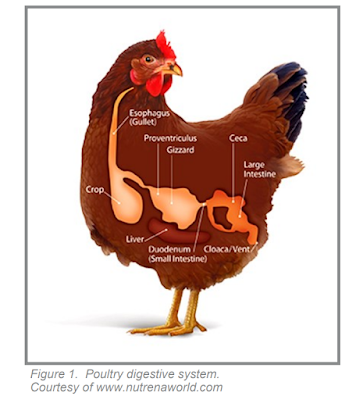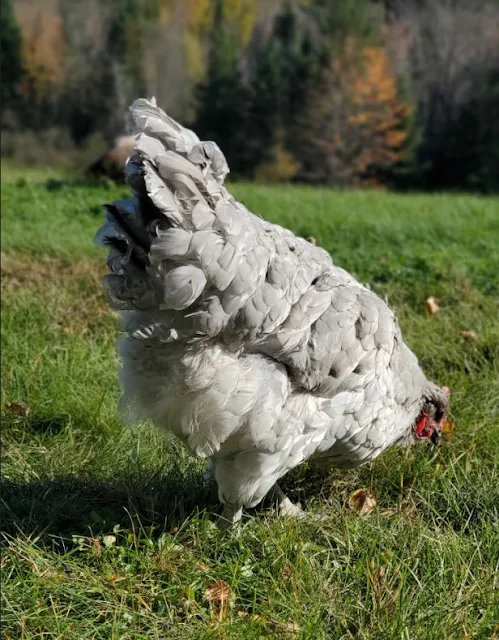Sour, Impacted and Pendulous Crop in Chickens
A chicken's digestive system is very different from a human's. Since chickens don't have teeth, they need a way to grind up the food they eat so their bodies can digest it.
And that is the purpose of a chicken crop.
The Chicken Crop
Sitting slightly to the right of the breastbone, the chicken's crop is the first stop the food makes after it enters the mouth and travels down the esophagus.
Located just beneath a chicken's neck, the crop is gradually filled throughout the day and then emptied overnight over the course of 24 hours.
What is the Purpose of the Crop?
As the hen eats throughout the course of the day (a chicken will generally eat about half a cup of food a day), all the food she eats is stored in the crop, which fills up little by little.
Because chickens are prey animals, this also allows them to eat quickly and then digest what they've eaten all day later - in a safer spot.
Overnight, the crop will slowly empty as the food is ground up and moves from the crop to the gizzard and then through the digestive system.
The Purpose of Grit
You might notice your chickens eating small pebbles, tones or coarse dirt as they roam your yard looking for bugs. In the absence of teeth, this is what they use to grind up their food.
If your chickens don't get out to free range regularly and have access to new ground to forage, then you will need to provide them with commercial poultry grit as a digestive aid.
Normal Appearance of the Chicken Crop
When you pick up one of your chickens in the morning and run your fingers down her front, you shouldn't be able to feel the crop. Her breast should be smooth and flat.
However, if you pick up that same chicken in the evening, her crop should be full and firm, maybe about the size of a racquetball or tennis ball, depending on the age and size of the chicken and how much she's eaten for the day.
The next morning, the crop should be flat and empty again.
If the crop is still full the next morning, you might have a case of impacted crop on your hands. If the crop is rock hard and not emptied come morning, that can signal impacted or blocked crop. An impacted crop can press against the wind pipe and suffocate a chicken.
The crop should be slightly soft when you squeeze it, with a bit of give, however it shouldn't be squishy. If the crop is soft and squishy, you can hear gurgling when you press on it, you smell a slightly 'off' scent on your chicken's breath or notice foul-smelling liquid dripping out of her mouth, that can signal sour crop.
This is a condition where the contents of the crop ferment and a bacterial yeast infection occurs.
Sour, Impacted and Pendulous Crop in Chickens
Sour crop and impacted crop are two different conditions which are often related, as is pendulous crop.
Oftentimes an impacted crop (which can occur if your chickens eats long strands of grass or other fibrous material, or non-edible items like string, rubber bands, paper, feathers, or pieces of plastic or rubber that get stuck in the crop) will become soured.
That's because it's not emptying correctly and the contents basically start to ferment and spoil. And the longer the crop is distended and can't empty, the more chance that another condition called pendulous crop can occur.
Pendulous crop becomes a problem when the crop gets impacted repeatedly and the crop muscle gets damaged, meaning it can no longer function the way it should. This can occur when your chickens are allowed to gorge and over stuff themselves, on treats for example, or overeat in general over a long period of time.
Once the muscles have been stretched out from the weight of excess food, they can't retract properly and the crop swings like a pendulum. A chicken with a pendulous crop can't process the food she eats correctly and can become malnourished and eventually will die.
Treating and Preventing Impacted Crop
- Limit access to long cut plant fibers, hay, grass (free ranging generally doesn't lead to impacted crops, but feeding long strands of grass you cut and feed to your flock can)
- Limit access to sand (no sand in the coop, please, it's just a bad idea for so many reasons)
- Ensure your chicken area is free of foreign objects your chickens might eat; such as string, baling twice, plastic or rubber bands
- Provide plenty of fresh water
- Provide access to grit
- Withhold solid food for 24 hours, offering only water
- Offer vegetable oil (by eye dropper if she won't drink voluntarily)
- Massage the crop gently with your fingers several times a day to break up the blockage
- Extreme cases might require slitting the crop open with a scalpel and removing the blockage (best left to a vet!)
Treating and Preventing Sour Crop
- Limit bread and other sugars in foods
- Treat impacted crop as soon as you notice it
- Add apple cider vinegar - its an antifungal! - to the water weekly (1 Tablespoon per gallon)
- Add probiotic powder to daily feed
- Hold the hen with her head facing the ground and gently massaging the crop towards her head to induce vomiting and empty the liquid in her crop (hold her upside down until the liquid stops coming out of her mouth to prevent her aspirating) Repeat several times a day.***
- Flush the crop with an Epsom salt wash (1 teaspoon salt in a cup of water)
- Offer plain yogurt
- Feed fresh or dried oregano or adding oregano oil to the water
- Feed fresh garlic or garlic powder
Treating and Preventing Pendulous Crop
- Prevent and quickly treat any crop impaction
- Limit treats
- Manually massage the crop gently to empty it each evening
- Realize the crop likely won't repair itself once its stretched out and consider your options as to long-term life decisions best for the hen such as a "crop bra" (basically a bandage that holds the crop in place) or other treatment
- Hens that develop pendulous crops should not be bred, since the condition can be genetic and passed down to chicks
So if you're new to chicken keeping, the next time you pick up one of your chickens and notice a large tumor-like protrusion on her breast late in the day, don't panic.
Its perfectly normal and just shows that your chickens have hearty appetites!
Fresh Eggs Daily Natural Poultry Feed Supplements






























